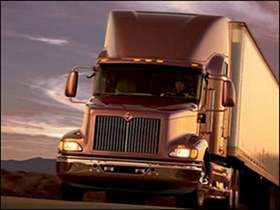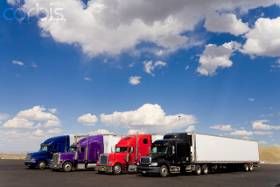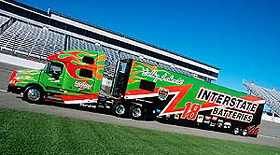Weights And Balances
Topic 1039 | Page 1
Hi all, I am on the weights and balances section on the high road quiz. My question is what does it mean to slide your tandem trailer wheels forward and backward? or moving the 5th wheel? I know to some this is a really stupid question.. I know there are no stupid questions, just stupid people who ask questions... lol... I would like an idea so I can almost visualize what that means.
Any and all info, as always, is greatly appreciated. Thanks,Kevin
do you ever see trucks and the trailer wheels are all the way back toward the doors or all the way forward toward the nose of the trailer? the reason is because the wheels can be slid back or forth to distribute the weight that you are hauling (take more weight off one set of axles and put more on another set).
same goes for the 5th wheel. it can be adjusted which is why you sometimes see a big gap between the nose of the trailer and the cab and other times its smaller.
Tandem:
Tandem Axles
A set of axles spaced close together, legally defined as more than 40 and less than 96 inches apart by the USDOT. Drivers tend to refer to the tandem axles on their trailer as just "tandems". You might hear a driver say, "I'm 400 pounds overweight on my tandems", referring to his trailer tandems, not his tractor tandems. Tractor tandems are generally just referred to as "drives" which is short for "drive axles".

Thanks for the info Jhon, to be honest I have never noticed this before, I will have to look more closely at the trucks as they roll pass me.

Kevin, a common truck, usually has a slidable 5th wheel. its easy to see if the 5th wheel will slde, as they will be mounted in a "rail" . The same holds true for trailer tandems. If you look under them, the tandems will be in a rail, with holes in it. Either one axle, or (more commonly) both tandem axles will slide forward or back, to more the weight in the back half of the trailer one way or another. If you see a traielr with a "spread axle".meaning the axles are separate from the other, then that might be a solid set spread axle, or a single slide spread axle, where either the front axle or the read axle can be slid to balance the weight in the trailer.Walking around a truck stop will teach you alot about different kinds of trailers. Our flatbed had solid set tandems, But we could lift the front axle up, so that when we had to spin the trailer, or make tight turns, we could lift that axle from a button in the cab. It saves on tires, and helps keep the axles from being "tweeked" when making tight turns. Its a good thing to remember when you are forced to make a REALLY tight turn....do it SLOW...making tight turns or spinnng your trailer to fast will "tweek" your tandems and it will bind up the slider, and track behind your truck crooked. If you have ever been behind a truck, and the trailer looks like its not travelling straight behind the truck, its usually because someone has spun the trailer, and now its "dog legged" (crooked). It will need to go to the shop and have the tandems aligned. If its not fixed, sliding the tandems will be a pain, and running down the road crooked will cost you in fuel mileage, and irregular tire wear.
Tandems:
Tandem Axles
A set of axles spaced close together, legally defined as more than 40 and less than 96 inches apart by the USDOT. Drivers tend to refer to the tandem axles on their trailer as just "tandems". You might hear a driver say, "I'm 400 pounds overweight on my tandems", referring to his trailer tandems, not his tractor tandems. Tractor tandems are generally just referred to as "drives" which is short for "drive axles".
Tandem:
Tandem Axles
A set of axles spaced close together, legally defined as more than 40 and less than 96 inches apart by the USDOT. Drivers tend to refer to the tandem axles on their trailer as just "tandems". You might hear a driver say, "I'm 400 pounds overweight on my tandems", referring to his trailer tandems, not his tractor tandems. Tractor tandems are generally just referred to as "drives" which is short for "drive axles".

Thanks Starcar, The only problem I have with going to a truckstop is the closest one to me is in fact nowhere near me. I live near Philly, and the closest one that I know of is on the North East extension. I dont no if you heard of that road or not, but it is an extension of I-476. There is another one in New Jersey but nowhere close to me. I dont even know of one in Delaware. But thanks for the help, it is much appreciated.
Thanks, Kevin

SLiding the tandems and the Fifth wheel should be taught while you are with your trainer on the road training. Make sure you ask about this. It very important for you to learn.
But basically you always slide tandems/5th wheel TOWARDS the problem or over weight area.
Tandems:
Tandem Axles
A set of axles spaced close together, legally defined as more than 40 and less than 96 inches apart by the USDOT. Drivers tend to refer to the tandem axles on their trailer as just "tandems". You might hear a driver say, "I'm 400 pounds overweight on my tandems", referring to his trailer tandems, not his tractor tandems. Tractor tandems are generally just referred to as "drives" which is short for "drive axles".
Tandem:
Tandem Axles
A set of axles spaced close together, legally defined as more than 40 and less than 96 inches apart by the USDOT. Drivers tend to refer to the tandem axles on their trailer as just "tandems". You might hear a driver say, "I'm 400 pounds overweight on my tandems", referring to his trailer tandems, not his tractor tandems. Tractor tandems are generally just referred to as "drives" which is short for "drive axles".

True, slide the tandems toward the problem (where there is too much weight); however, I ran into this problem several weeks ago: the GVW at about 75K was well under the max of 80K, yet both the trailer tandems and the steer axle were over their respective maximums of 34K and 12K respectively.
If the tandems were slid toward the steer axle, that would obviously put more weight on the trailer tandems; yet if the tandems were slid toward the trailer tandems, you would think it would place more weight on the steer axle as well as the drive tandems (which were very light).
Finally, had the trailer tandems slid all the way to the back and solved both problems. Apparently, by placing more of the weight on the drive tandems, it actually lightened the steer axle enough to be legal. Problem was that the Shipper did a lousy job of loading with too much light stuff at the front of the trailer and too much heavy stuff at the back of the trailer.
Anybody else ever have to deal with a similar situation?
Shipper:
The customer who is shipping the freight. This is where the driver will pick up a load and then deliver it to the receiver or consignee.
Tandems:
Tandem Axles
A set of axles spaced close together, legally defined as more than 40 and less than 96 inches apart by the USDOT. Drivers tend to refer to the tandem axles on their trailer as just "tandems". You might hear a driver say, "I'm 400 pounds overweight on my tandems", referring to his trailer tandems, not his tractor tandems. Tractor tandems are generally just referred to as "drives" which is short for "drive axles".
Tandem:
Tandem Axles
A set of axles spaced close together, legally defined as more than 40 and less than 96 inches apart by the USDOT. Drivers tend to refer to the tandem axles on their trailer as just "tandems". You might hear a driver say, "I'm 400 pounds overweight on my tandems", referring to his trailer tandems, not his tractor tandems. Tractor tandems are generally just referred to as "drives" which is short for "drive axles".
True, slide the tandems toward the problem (where there is too much weight); however, I ran into this problem several weeks ago: the GVW at about 75K was well under the max of 80K, yet both the trailer tandems and the steer axle were over their respective maximums of 34K and 12K respectively.
If the tandems were slid toward the steer axle, that would obviously put more weight on the trailer tandems; yet if the tandems were slid toward the trailer tandems, you would think it would place more weight on the steer axle as well as the drive tandems (which were very light).
Finally, had the trailer tandems slid all the way to the back and solved both problems. Apparently, by placing more of the weight on the drive tandems, it actually lightened the steer axle enough to be legal. Problem was that the Shipper did a lousy job of loading with too much light stuff at the front of the trailer and too much heavy stuff at the back of the trailer.
Anybody else ever have to deal with a similar situation?
Yep, got overloaded once on my trailers too. I was at maximum kingpin setting for IL and my trailers were overweight by about 2,000. Even slid all the way back they were still overweight by 600. I made no money that day.
Shipper:
The customer who is shipping the freight. This is where the driver will pick up a load and then deliver it to the receiver or consignee.
Tandems:
Tandem Axles
A set of axles spaced close together, legally defined as more than 40 and less than 96 inches apart by the USDOT. Drivers tend to refer to the tandem axles on their trailer as just "tandems". You might hear a driver say, "I'm 400 pounds overweight on my tandems", referring to his trailer tandems, not his tractor tandems. Tractor tandems are generally just referred to as "drives" which is short for "drive axles".
Tandem:
Tandem Axles
A set of axles spaced close together, legally defined as more than 40 and less than 96 inches apart by the USDOT. Drivers tend to refer to the tandem axles on their trailer as just "tandems". You might hear a driver say, "I'm 400 pounds overweight on my tandems", referring to his trailer tandems, not his tractor tandems. Tractor tandems are generally just referred to as "drives" which is short for "drive axles".
ATXJEHU, if your 5th wheel is adjustable, it sounds like it may be one notch off. Do you remember how much fuel you had in the truck when you scaled it out?
Generally the majority of weight from fuel goes to the steer tires. And yes, putting more weight on the tractor drives can take a little weight off the steer axle at times. That depends on the placement of your 5th wheel.
But in 15 years of driving I can't remember ever being over on the steer axle and trailer tandems , but OK on the tractor drives. It had to have happened I guess, but not very often.
If your 5th wheel is adjustable, a great way to determine where to put it is to scale the truck when you're very close to 80,000 gross with somewhere around 1/2 tank of fuel. Set your trailer tandems so they're as close to 34,000 as you can possibly get them.
At that point you should be able to get it to balance out very close to 12,000-34,000-34,000. If you're more like 11,600-34,400-34,000 then you need to slide your 5th wheel one notch forward to put more weight on the steers. If you're more like 12,600-33,400-34,000 then you need to slide your 5th wheel one notch back to take some weight off the steers.
But with 34,000 on the trailer tandems, about 1/2 tank of fuel, and your gross weight just about at 80,000 you should be able to get the whole truck to balance out.
If you don't have an adjustable 5th wheel, there isn't anything you can do. But once you get your 5th wheel in the proper location, leave it alone. You won't ever need to touch it. Every time I got a new truck I would do a check like this to make sure it was in the right spot. Usually it is, once in a while it's not. There really is an ideal location for it, so get it as close to ideal as possible and leave it alone. You'll never need to adjust it.
For people who are ready to throw up because they have no idea what I'm talking about, don't sweat it a bit. Our High Road Online CDL Training Program has a "Weight & Balance" section that covers all of this thoroughly.
CDL:
Commercial Driver's License (CDL)
A CDL is required to drive any of the following vehicles:
- Any combination of vehicles with a gross combined weight rating (GCWR) of 26,001 or more pounds, providing the gross vehicle weight rating (GVWR) of the vehicle being towed is in excess of 10,000 pounds.
- Any single vehicle with a GVWR of 26,001 or more pounds, or any such vehicle towing another not in excess of 10,000 pounds.
- Any vehicle, regardless of size, designed to transport 16 or more persons, including the driver.
- Any vehicle required by federal regulations to be placarded while transporting hazardous materials.
Tandems:
Tandem Axles
A set of axles spaced close together, legally defined as more than 40 and less than 96 inches apart by the USDOT. Drivers tend to refer to the tandem axles on their trailer as just "tandems". You might hear a driver say, "I'm 400 pounds overweight on my tandems", referring to his trailer tandems, not his tractor tandems. Tractor tandems are generally just referred to as "drives" which is short for "drive axles".
Tandem:
Tandem Axles
A set of axles spaced close together, legally defined as more than 40 and less than 96 inches apart by the USDOT. Drivers tend to refer to the tandem axles on their trailer as just "tandems". You might hear a driver say, "I'm 400 pounds overweight on my tandems", referring to his trailer tandems, not his tractor tandems. Tractor tandems are generally just referred to as "drives" which is short for "drive axles".

Thanx Brett, great point about the 5th wheel placement, but mine is fixed. Yes, I was dumbfounded by the weight being split the way it was and, so far, that's the only time its happened to me. Nothing like having to watch those trailer tandems making corners when they're slid all the way way back!
Tandems:
Tandem Axles
A set of axles spaced close together, legally defined as more than 40 and less than 96 inches apart by the USDOT. Drivers tend to refer to the tandem axles on their trailer as just "tandems". You might hear a driver say, "I'm 400 pounds overweight on my tandems", referring to his trailer tandems, not his tractor tandems. Tractor tandems are generally just referred to as "drives" which is short for "drive axles".
Tandem:
Tandem Axles
A set of axles spaced close together, legally defined as more than 40 and less than 96 inches apart by the USDOT. Drivers tend to refer to the tandem axles on their trailer as just "tandems". You might hear a driver say, "I'm 400 pounds overweight on my tandems", referring to his trailer tandems, not his tractor tandems. Tractor tandems are generally just referred to as "drives" which is short for "drive axles".
HOS:
Hours Of Service
HOS refers to the logbook hours of service regulations.New Reply:
New! Check out our help videos for a better understanding of our forum features

















Preview:








 TT On Facebook
TT On Facebook
Hi all, I am on the weights and balances section on the high road quiz. My question is what does it mean to slide your tandem trailer wheels forward and backward? or moving the 5th wheel? I know to some this is a really stupid question.. I know there are no stupid questions, just stupid people who ask questions... lol... I would like an idea so I can almost visualize what that means.
Any and all info, as always, is greatly appreciated. Thanks,Kevin
Tandem:
Tandem Axles
A set of axles spaced close together, legally defined as more than 40 and less than 96 inches apart by the USDOT. Drivers tend to refer to the tandem axles on their trailer as just "tandems". You might hear a driver say, "I'm 400 pounds overweight on my tandems", referring to his trailer tandems, not his tractor tandems. Tractor tandems are generally just referred to as "drives" which is short for "drive axles".